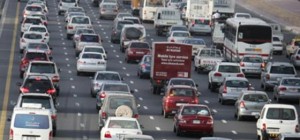By Surabhi Vaya www.hindustantimes.com
Sunday is World Environment Day, but Mumbai has little to celebrate. The latest statistics show that pollution levels have been rising due to a steady increase in the vehicle population.
 According to statistics obtained from the State Transport Department, around 300 cars and 400 two-wheelers are re gistered every day in Mumbai. Between March 2009 and March 2010, 1,31,379 vehicles were registered — a 19.07% increase over the number of vehicles added to Mumbai’s roads in the preceding 12 months.
According to statistics obtained from the State Transport Department, around 300 cars and 400 two-wheelers are re gistered every day in Mumbai. Between March 2009 and March 2010, 1,31,379 vehicles were registered — a 19.07% increase over the number of vehicles added to Mumbai’s roads in the preceding 12 months.
“Some of the most polluting vehicles are the Brihanmumbai Municipal Corporation (BMC) garbage dumpers and other such vehicles, which are badly maintained,” said Nitin Dossa, executive chairman of the Western India Automobile Association (WIAA).
The city has 678 dumpers, few of which meet the emission standards. “Since 2005, we have been following Bharat Stage III, which is equivalent to European standards. But most of these dumpers are still on Bharat Stage II,” Dossa said.
However, the dumpers are only part of a larger issue. According to experts, the fault lies largely with anyone who owns a vehicle. Statistics show that during peak hours, carbon emissions from two-wheelers rise by 75% compared to 42% during non-peak hours.
“Most vehicle owners don’t do simple things like getting their car filters changed, their cars checked or keeping their Pollution Under Control (PUC) certificate updated. These little things will go a long way in reducing emissions,” said Sunil Merchant, former president of WIAA.
“More than 70% of air pollution comes from vehicles, while the rest is industries and others. An increase in vehicles, coupled with limited capacity of roads to accommodate the rise is the reason behind the increase in pollution,” said Ajit Saraf, joint director for Water Pollution Control, Maharashtra Pollution Control Board.
Saraf added that while emission standards can ensure reduce pollution, no standard can make vehicles pollution-free. “An increase in the number of vehicles means that cumulative emissions rise. While vehicles may comply to emission norms, the rising numbers on our roads call for stricter standards,” said Saraf.
“The only way out,” said Merchant, “is an improved and accessible mass transport system.” Citing the example of the Delhi Metro, Merchant said the transport system in Mumbai is not an incentive for people to give up their cars.
For now, experts agree that vehicles owners need to make changes to reduce emissions.
“People ought to do small things like turning off the ignition at signals or ensuring that PUCs are updated. This will cultivate a disciplined approach towards the environment,” said Brijesh Singh, additional commissioner of police (Traffic).
















